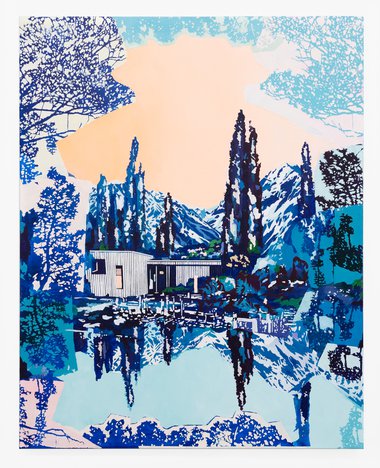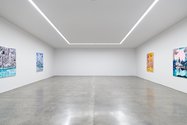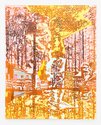John Hurrell – 6 November, 2024
Flat unmodulated hue is used in overlapping layers to create a dense plethora of ‘shredded' hovering arboreal, architectural, and landform-derived marks that dominate the picture-plane. One perceives whole vertical rectangles vaguely ‘patterned' and not bisected by any immediately detectable horizontal water's edge.
Using multiple dark forms against a pale background to delineate central Otago landscapes, with lakeside weatherboard buildings surrounded by leaf-filled trees, visiting Australian artist Paul Davies’ large busy paintings exploit low keyed tone and a dynamic of deliberately overloaded shape. Its dramatic chromatic manipulation and overt density creates a flickering optical vibrancy. A dappled ambience.
His six multicoloured works at Starkwhite have a chopped up collaged quality with ‘glued-on’, juxtaposed sections of ‘cut-out’ textures, so there is no clear horizontal dividing edge between airy scenery and watery reflection. Overall the sections blend with shrewdly positioned chunks of imagery accompanied by the occasional disruptive zigzagging edge. There is a deliberate avoidance of smooth pictorial integration.
Flat paint (with undercoats peeking through) is used in thin layers. These depict a dense plethora of ‘shredded,’ hovering arboreal, architectural, and landform-derived marks that dominate the picture-plane. One perceives whole vertical rectangles vaguely ‘patterned’ and not bisected by any immediately detectable horizontal water’s edge.
Though often constructed to incorporate tall narrow poplars on a skyline, and horizontal wooden buildings reflected in still water, these are vaguely modernist paintings that you look at, not through. Their title suggests they are part of a sequence, and that they have the spatial ambience of a continuous ‘field’ not a ‘vista’.
Strangely they are still a sort of opaque abstraction overall, even though you recognise the many separate floating parts. And there is in these artworks a lot of subtle humour, slyly fiddling with sections of inverted reflections for example, in a way foreign to the holism of water-based images one finds mirrored in the real world.
These are playful though perplexing works that welcome close scrutiny. Challenging but immensely rewarding too, Davies’ paintings appear to be about the outdoor world of natural environs whilst really focussing on techniques of spatial analysis that could also occur indoors anytime.
John Hurrell



 Two Rooms presents a program of residencies and projects
Two Rooms presents a program of residencies and projects Advertising in this column
Advertising in this column



This Discussion has 0 comments.
Comment
Participate
Register to Participate.
Sign in
Sign in to an existing account.